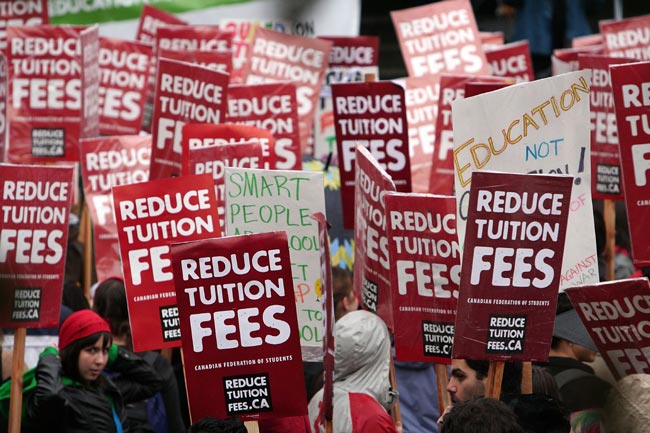
For the third year in a row, undergraduate students at Florida’s 11 public universities will pay 15 percent more in tuition.
The governing board for the State University System approved a 7 percent increase in tuition on Thursday. That’s on top of an 8 percent tuition increase approved by the Legislature earlier.
Click On:
- College Drop-Outs: Florida Lawmakers Cutting Bright Futures Scholarships a Further 20%
- Stetson University and Flagler College Rank Well, Florida Does Not in Higher Ed Survey
At both the University of Central Florida in Orlando and the University of Florida in Gainesville, tuition for the year–based on 30 credit hours–was 5,020 this year. It’s rising to $5,700. Figures are slightly lower at the University of North Florida, where tuition is rising from $4,908 this year to $5,644.
At Florida State, tuition this year was $5,198 for the year. It’s increasing $780, to $5,978. Over the past 10 years, tuition at the two universities has increased close to 140 percent. (It was $2,513 at Florida State in 2002.)
All of the Board of Governors voted for the increase, except Michael Long, the student representative from New College, who chose to vote against the increase for Florida Gulf Coast University and University of North Florida. Long said he was reflecting earlier votes by student body presidents at those schools.
The tuition increases come at a time when financial aid programs, such as the popular Bright Futures scholarship, are being cut, leaving students with bigger tuition bills.
The tuition increases are especially sever when compounded with this year’s 20 percent cut in Bright Futures, which Florida awarded to all Florida students with grade point averages of 3.5 or better. In the 2009-2010 school year, 746 Flagler County students attending college in the state received Bright Futures scholarships.
The typical Bright Futures student attending, say, the University of Florida a few years ago had her entire tuition bill covered. That began to change two years ago as the Legislature reduced the amounts it would cover. This year’s 20 percent cut means that students going to UF in fall will get only $3,000 from Bright Futures for the year (30 credit hours), barely more than half the tuition bill.
Some Board of Governors members are beginning to examine how tuition increases are impacting middle class students who aren’t eligible for need-based aid.
“We are looking at it,” said Tico Perez, a member of the Board of Governors and the chair of the board’s Budget and Finance Committee. Perez said the additional financial aid given to offset tuition increases is aimed at federal Pell grant recipients, who must meet federal low-income requirements to qualify.
“As tuition continues to increase, as Bright Futures continues to be cut…it is creating more and more of a challenge and we need to take a look at whether or not we broaden access to financial aid,” Perez said.
Universities argue that Florida students pay far less than students in other states for tuition. Florida ranks 48 in the cost of tuition and fees compared to other states, according to the College Board. But the gap is shrinking. The national average for a year’s tuition at public universities this year was $7,605 (the highest rate was in Vermont, at $12,500).
Fifteen percent is the maximum amount universities are allowed to increase tuition in a given year under state law. They are aiming to continue to to do so for foreseeable years.
University presidents spent most of Wednesday pleading their case for tuition increases to the Board of Governors. They said the hikes were needed to offset severe cuts in state funding. If it weren’t for tuition increases, universities would have to fire faculty, increase class sizes, and kill off academic programs and courses.
Some of Florida’s biggest universities – such as Florida State and the University of Florida – are fearful of losing prominent faculty and increasing class sizes because it could hurt their effort to climb in national rankings.
Some university officials are pushing for increases of more than 15 percent, such as University of Florida President Bernie Machen. The idea of the cap was to give universities time to catch up to the national average. But as other universities have also increased tuition, the national average has become a moving target.
There may be no end in sight for tuition increases in Florida. Universities disclosed to the governing board this week that without significant improvement in the economy, 15 percent tuition hikes will continue to be necessary every year. Each university, except for the University of North Florida, projected 15 percent increases the next four years.
Data presented to the Board on Thursday showed it would take at least 10 years to reach the national average assuming universities asked for 15 percent tuition increases each year, and assuming the national average of tuition and fees rose at 7 percent each year, which is the same percentage as the last five years.
“It creates a bit of a challenge to catch up to the national average,” Perez said. But he added that meeting the average is “not the goal” and is simply a “measuring device.”
–Lilly Rockwell, News Service of Florida, and FlaglerLive





























Jenn Kuiper says
This is another reason to enroll in a Florida Prepaid College Plan now, before tuition goes up even more and while your kids are young. Here’s their website for more info: http://www.myfloridaprepaid.com/
notasenior says
On the Sunday talk shows last week, the Republican talking heads were clammoring that education spending has increased too much. Their statistic – since 1990 school funding had doubled. How much have your costs gone up since 1990?
flashbacc says
its almost gone up by 147%